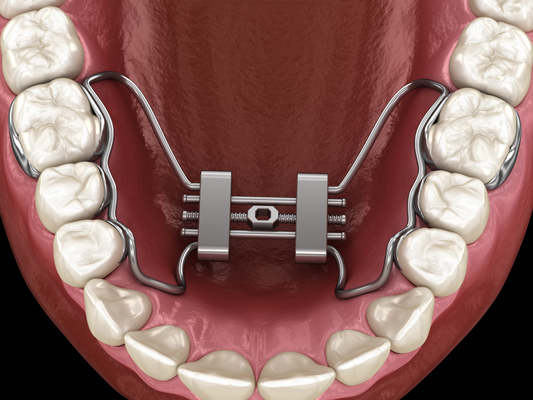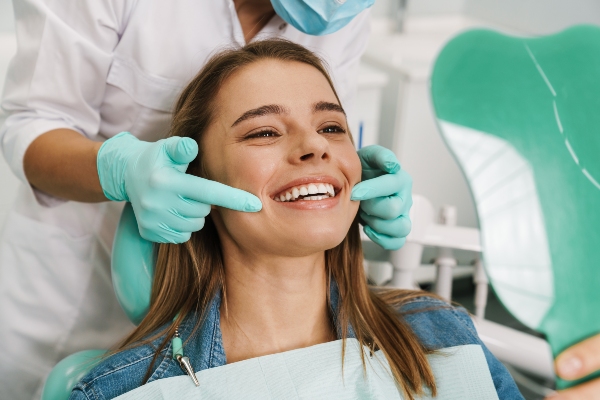How a Palatal Expander Works

A palatal expander is an oral appliance that is used to widen the upper jaw. Also known as a palate or orthodontic expander, these appliances fit in the roof of your mouth and gradually move the two halves of your jawbone apart by applying constant pressure on the area.
Some of the issues a dentist might recommend a palatal expander for include:
- Overlapping teeth
- Crowded teeth
- Impacted teeth
- Crooked teeth
- A misaligned bite
- Chewing issues
How a palatal expander widens your jaw
Dentists typically recommend palatal expanders to improve how a patient’s upper and lower set of teeth fit together or to create more space on the jaw for their teeth. Expanding the palate can also help to reduce the symptoms of obstructive sleep apnea.
A palatal expander can be used by children and adults alike. Dentists usually recommend getting children started with orthodontic treatments around the ages of seven to eight. Children still have soft bones at this stage in their development, making it easier to widen their jaw. Getting children started with orthodontic treatments this early on typically helps to avoid needing more invasive treatments in the future. Widening the jaws of teenagers and adults usually takes longer since their bones have already hardened.
Types
There are several types of palatal expanders commonly used in dentistry. Some of these appliances are removable, while others are implant-supported. Some of the palatal expanders a dentist might recommend include:
1. Removable palate expander
This appliance looks a lot like a retainer, but it is made out of chrome instead of acrylic. These removable appliances are typically recommended for patients who only need to widen their jaw a bit.
2. Rapid palate expander
These appliances fit in the roof of your mouth and are attached to the patient’s back upper teeth for extra stability. They come with small screws in the middle that are turned a little each day with a special key to increase the tension the appliance puts on the palatal bones. Over time, this pushes the two palatal bones away from each other, widening the patient’s jaw.
Rapid orthodontic expanders are extremely effective tools that widen teeth at a rate of up to 0.5 millimeters daily. Most patients get their desired results within six months of using these devices.
3. Surgically assisted rapid palate expander
These devices are reserved for adults with moderate to severe jaw alignment or size issues. The appliance is surgically attached to the mid-palatal suture and relies on the patient’s back teeth for support. As is the case with rapid expanders, patients will need to activate the expander daily to increase the tension it puts on their palatal structures.
4. Implant-supported palate expander
These are typically used on teens and adults, and they work by applying force to four mini implants inserted into the patient’s jaw. This allows the dentist to apply pressure directly to the patient’s upper jaw. Patients might need to be referred to an oral surgeon who performs the surgical placement of the implants.
Improve your bite with palatal expanders
You might need a palatal expander if you have teeth alignment issues like overlapping, crooked, and misaligned teeth. Call or visit our Madison clinic to set up an appointment.
Request an appointment here: https://rosecityorthodontics.com or call Rose City Orthodontics at (973) 245-9577 for an appointment in our Madison office.
Check out what others are saying about our services on Yelp: Palatal Expander in Madison, NJ.
Related Posts
A confident and attractive smile can enhance self-esteem and the teeth's functionality. If you want to straighten your smile or correct misalignments, it is recommended to find an orthodontist. These dental professionals specialize in diagnosing, preventing, and treating teeth and jaw alignment issues, offering many solutions such as braces, clear aligners, and retainers. This blog…
When trying to find an orthodontist online, there are several factors to consider to conduct a thorough and successful search. No one should compromise on this task, as an orthodontist plays a major role in treating misaligned teeth and biting issues, which are beneficial to one’s overall oral health. Changing orthodontists down the road can…
There are several compelling reasons to find an orthodontist for fixing crooked, crowded, or misaligned teeth—and they are not all cosmetic. Yes, having a straight smile is attractive, but the benefits do not stop there. Here is a closer look at some key reasons to find an orthodontist for teeth straightening.Many dentists will offer teeth…
Finding an orthodontist offering preventive services is important to protect your oral health and overall well-being. After all, maintaining good oral health goes further than regular brushing and flossing. While dentists are essential to regular preventive care, orthodontists specialize in diagnosing and treating misaligned teeth and jaw alignment issues. This blog will explore the benefits…


